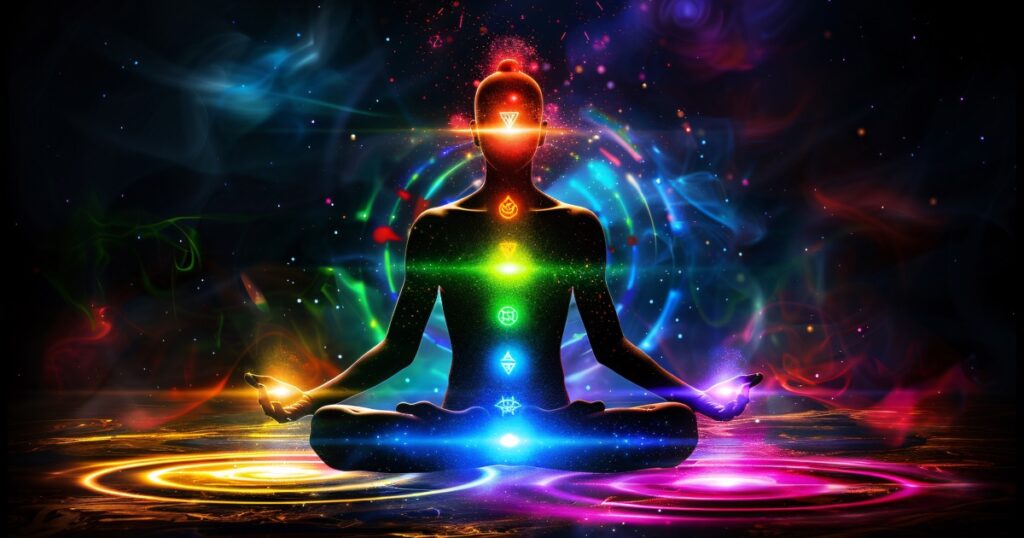In today’s always-on world, stress is chronic. According to the American Institute of Stress, nearly 77% of people experience physical symptoms caused by stress regularly. From burnout and insomnia to anxiety and digestive issues, the modern lifestyle takes a toll on our nervous systems and emotional well-being.
Yet while we chase solutions through productivity hacks or wellness trends, we often overlook something deeper: the energetic root of our imbalance.
This is where chakra balancing comes in. Rooted in ancient Indian healing systems, the concept of chakras has transcended time because it speaks to something universal, our need for inner alignment. And now more than ever, it offers a path for restoring calm, clarity, and control.
What Are Chakras?

Chakras are energy centers in the body that correspond to specific nerve bundles and internal organs. There are seven primary chakras aligned along the spine, from the base to the crown of the head.
Each governs unique emotional, physical, and spiritual functions. When these centers are balanced and open, energy flows freely. But when they are blocked or misaligned, that energy stagnates, often manifesting as emotional distress, physical pain, or mental overload.
Understanding your chakras is not about adopting a new belief system. It’s about tuning into the body’s natural rhythm and recognizing how energy affects your stress response.
Start your journey to emotional and energetic alignment. Reach out to Dr. Petra Frese today and experience transformational healing.
The 7 Main Chakras

Root Chakra (Muladhara)
- Location: Base of spine
- Color: Red
- Element: Earth
- Governs: Safety, security, and financial stability
- Stress Symptoms: Anxiety, insecurity, chronic fatigue, feeling ungrounded
Sacral Chakra (Svadhisthana)
- Location: Lower abdomen
- Color: Orange
- Element: Water
- Governs: Creativity, sensuality, emotional flow
- Stress Symptoms: Mood swings, guilt, lack of intimacy, or creative blocks
Solar Plexus Chakra (Manipura)
- Location: Upper abdomen
- Color: Yellow
- Element: Fire
- Governs: Confidence, willpower, identity
- Stress Symptoms: Digestive issues, self-doubt, irritability
Heart Chakra (Anahata)
- Location: Center of chest
- Color: Green
- Element: Air
- Governs: Love, compassion, forgiveness
- Stress Symptoms: Loneliness, resentment, tight chest or shallow breathing
Throat Chakra (Vishuddha)
- Location: Throat
- Color: Blue
- Element: Ether
- Governs: Communication, truth, expression
- Stress Symptoms: Sore throat, frustration, inability to speak up
Third Eye Chakra (Ajna)
- Location: Between the eyebrows
- Color: Indigo
- Element: Light
- Governs: Intuition, insight, imagination
- Stress Symptoms: Brain fog, overthinking, poor decision-making
Crown Chakra (Sahasrara)
- Location: Top of the head
- Color: Violet or white
- Element: Consciousness
- Governs: Spiritual connection, purpose, enlightenment
- Stress Symptoms: Existential dread, depression, disconnection
How Chakra Imbalances Contribute to Stress
When you’re constantly stressed, your energy field contracts. You may find it hard to sleep, feel emotionally reactive, or become disconnected from your intuition. These symptoms are often tied to overactive or underactive chakras. For instance, overthinkers often have an overstimulated Third Eye Chakra but a blocked Root Chakra, meaning they live in their heads and feel unsafe in their bodies.
Balancing your chakras isn’t just a spiritual idea. It’s a grounded, practical strategy to restore energetic flow, which leads to physical vitality and emotional clarity.
Chakra Balancing Techniques for Daily Practice
- Mindful Breathing and Visualization: Each morning, breathe deeply while visualizing light flowing through each chakra, starting from the root up. Picture each one glowing in its respective color.
- Sound Healing: Listening to chakra-specific frequencies (like 528 Hz for the heart) or using tuning forks and singing bowls can help restore harmony.
- Affirmations: Use positive statements aligned with each chakra. For example, for the Solar Plexus: “I stand in my personal power and act with confidence.”
- Color Therapy: Wear clothes or decorate your space with chakra-aligned colors to influence your mood and energy.
- Yoga Poses: Incorporate poses that activate specific chakras, like Warrior I for the Root or Camel Pose for the Heart.
Working With an Energy Work Professional

While DIY techniques are a powerful start, working with a certified energy work expert can be transformative. Professionals use intuitive assessments and tools like chakra diagnostics and guided meditations tailored to your specific energy field. This personalized guidance helps you:
- Identify blocked or overactive chakras
- Heal past emotional traumas impacting your energy body
- Develop sustainable practices for long-term balance
Many clients report feeling emotionally lighter, physically energized, and mentally clear after just a few sessions. Whether you’re an executive managing burnout or a parent juggling emotional overload, professional energy work provides clarity and realignment when self-help falls short.
In Summary
Chakra balancing is more than a wellness trend; it’s a lifelong tool for managing stress, improving resilience, and reconnecting with your full self. In a world that pulls your energy in a thousand directions, these techniques bring you back to center.And when you’re ready to go deeper, consider working with Dr. Petra Frese, a renowned energy healer and spiritual coach based in Allentown, Pennsylvania. With her unique blend of scientific expertise and intuitive healing, Dr. Frese can help you unlock the full potential of your body’s wisdom. Because healing begins with energy, and energy begins with awareness.

